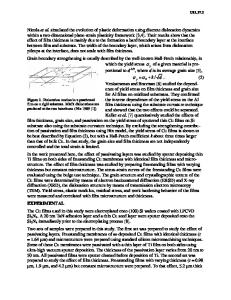Influence of Film Thickness and Capping Layer on the Mechanical Properties of Copper Films
- PDF / 435,000 Bytes
- 6 Pages / 414.72 x 648 pts Page_size
- 54 Downloads / 614 Views
ABSTRACT Substrate curvature and X-ray technique were used to study the mechanical properties of Cu films. Stress-temperature curves were measured using both methods. An additional analysis of the X-ray peak width allows us to estimate grain size and dislocation density as a function of temperature. It can be shown that a capping layer changes the mechanical properties of a Cu film strongly and that in capped films dislocation processes seem to be more important than diffusion at high temperatures. INTRODUCTION Metallization research in the last few years has focused on copper as a potential alternative to aluminum, because of its higher electrical and thermal conductivity. However the product of elastic modulus and thermal expansion coefficient of Cu is higher than for Al, causing high thermal stresses and therefore potential reliability problems. The mechanical properties of continuous Cu films with different barrier layers and capping layers [1-3] have been investigated, but little in-situ information about the evolution of microstructure during stresstemperature (c-T) cycles is available. We have used a combination of substrate curvature and
X-ray methods to investigate the mechanical behavior and the microstructure of Cu films in-situ during a-T cycles. EXPERIMENTAL DETAILS Substrates were 100 mm diameter wafers with 50 nm thermal oxide. 50 nm thick Si3 N4 underlayers were deposited on both sides of the wafers by LPCVD and densified at 950'C for one hour. Cu films were then deposited by room temperature (RT) sputtering at a rate of 1020 A/min to thicknesses of 0.6 gm and 1 pim. Some of these Cu films were capped with a 50 nm Si 3 N 4 layer that was sputter deposited to avoid changes in the microstructure of the Cu films. A corresponding Si3 N 4 layer was sputtered on the back side of the wafer. The substrate curvature technique was used to determine the biaxial stresses in the Cu film as a function of temperature. The curvature of the substrate was measured using a laser-based optical lever device and stresses were calculated using a data analysis method similar to reference [1]. The stresses in the films were determined for several thermal cycles from RT up to a maximum of 600TC and back with a constant heating and cooling rate of 60 C/min. The special layer arrangement on the wafer allowed the determination of the stresses only in the Cu films as the curvatures caused by the cap layers and the diffusion barrier layers on the front and back side of the wafer compensate each other. The samples were cycled in a nitrogen furnace atmosphere to prevent oxidation of the Cu-layer. A reducing organic foil was also placed in the furnace which is widely used in the microelectronic industry [4]. 309 Mat. Res. Soc. Symp. Proc. Vol. 391 ©1995 Materials Research Society
For the X-ray investigations, a Siemens D5000 powder diffractometer with Cu-Kct radiation was used. The sample was fixed on a resistance heated platinum ribbon in a vacuum chamber and cycled between RT and 600'C with a heating and cooling rate of 6°C/min
Data Loading...











